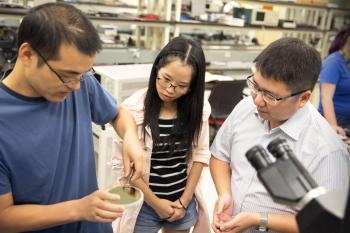Sep 22 2016
Neuro-inspired computing has provided a common intersection for three seemingly varied fields: microelectronics, computing and neuroscience.
 As part of his National Science Foundation CAREER award, Shimeng Yu (right) is providing interdisciplinary educational opportunities in neuro-inspired computing research for students in his lab. Pictured Rui Liu (center), an electrical engineering student, and Ligang Gao, an assistant research scientist. (Credit: Pete Zrioka/ASU)
As part of his National Science Foundation CAREER award, Shimeng Yu (right) is providing interdisciplinary educational opportunities in neuro-inspired computing research for students in his lab. Pictured Rui Liu (center), an electrical engineering student, and Ligang Gao, an assistant research scientist. (Credit: Pete Zrioka/ASU)
Neuro-inspired computing is a growing area in computer engineering that intends to imitate the perception, cognition and action abilities of the human brain in our computer systems.
Some of the first computing systems were inspired by neural systems. However, these systems adopted a different approach as they evolved.
Shimeng Yu, an assistant professor believes that the field of computer engineering requires a radical shift back to the earlier neuro-inspired designs.
This shift would move away from the traditional von-Neumann architectural methods that have been in use for the past 70 years, and will provide longer battery life and faster processing.
Yu intends to promote neuro-inspired computing by employing the emerging nano-device technologies to develop a self-learning chip.
The National Science Foundation CAREER award that identifies emerging research and education leaders in science and engineering has partially supported Yu’s research.
A Self-Learning Microchip
The microchip (a packaged computer circuitry unit) developed by Yu has the ability to adapt to its environment, understand things in near real time, and make informed decisions without any help, with considerably less power consumption.
The microchip can be embedded in sensor devices and mobile phones, and can be used to perform complex tasks. This makes the chip useful in “a wide range of applications with profound consequences to our society,” said Yu.
Combined with power-efficient mobile platforms, the smart information processing can enhance new markets in self-driving cars and facial recognition software.
The microchip can also be used for defense and security applications that are used for real time surveillance and identification of objects and people.
If connected to front-end sensors, the chip can have “a groundbreaking impact on the Internet of Things from chemical and gas sensors to smart wearable systems used in social networks to personalized health-care applications,” said Yu, who added that the battery lifetime of these devices could also be extended to a great extent.
Yu’s unique technical approach involved using a crossbar array and resistive synaptic devices in tandem. In this system, a crossbar array is formed by crisscrossing orthogonal wires, and a resistive synaptic device is placed at each cross-point. A resistive synaptic device is a resistor whose conductance alters due to programming voltage pulses.
Simliar to how a human brain accquires and processes new neural information, the learning of the chip is initiated by the alterations in conductance.
The properties of human brain’s synapses are emulated by the resistive synaptic device. The tiny gaps at the end of neurons that facilitate the passing of chemical or electrical signals between two neurons are called as synapses. When two connected neurons become active, there is an alteration in the conductance of their synapses, which spurs the learning of new information.
Contributing to a Radical Shift
The recent discoveries made by Yu signal a shift in the architectural approach in computing paradigm from von-Neumann to neuro-inspired approach. The von-Neumann architecture employed today consists of separate memory and processor. The processor uses data bus to fetch data from the memory for processing.
However, the limited bandwidth in this technique creates a memory wall problem in data-intensive applications.
The back-and-forth data transfer causes a bottleneck in performance and consumes the most energy in the system.
Yu.
The neuro-inspired architecture localizes the process more efficiently, and emulates the human brain.
The human brain, with its neurons and synapses is a distributed computing system in itself.
Neurons are simple computing units and synapses are local memories, and they are massively connected in a neural network through communication channels.
Yu.
Fetching data locally and processing them by neurons is easier as the neural data is stored in the synapses that are near the neuron units.
Imitating neural process for computing can remove issues such as data traffic jams or memory wall problem encountered in the von-Neumann architecture.
Yu is also incorporating educational opportunities for students in his research endeavors as a part of his CAREER award. He believes it to be an ideal opportunity to train graduate and undergraduate students in interdisciplinary skills.
The cross-layer nature of this research, ranging from semiconductor device and circuit design to electronic design automation and neuro-inspired machine learning, provides an ideal platform for preparing interdisciplinary students.
Yu.
“The beautiful analogy between artificially fabricated synaptic devices and biological synapses in our neural systems has always fascinated me,” he said. This parallel will be the driving force behind Yu’s teaching and research efforts as he brings in the next phase of computing architecture.
Source: https://asunow.asu.edu/